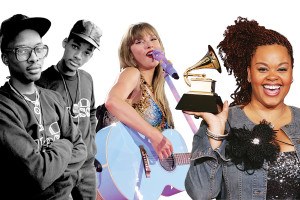“This Is What Democracy Looks Like” — But Is the DNC Seeing It?
I emerged from City Hall exit of the subway to the sound of Andean music and humid heat that aggressively wrapped itself around me, tight as a tourniquet. It was just after noon, and City Hall was bustling with protestors.
$15 minimum wage, climate change, TPP, socialism — the signs (and t-shirts) identified the groups as Bernie’s nation. People talked to passersby about people in America being one paycheck away from homelessness.
I had expected they’d be there, of course, but maybe not completely girding the venerable heart of Philadelphia. Most of them younger than me, many of them white — but by no means all. There was a big papier-mâché puppet of Berta Cáceres, the Honduran indigenous and environmental activist (and strong critic of Hillary Clinton’s actions during her stint as Secretary of State) killed in March of this year, as well as some signs held by Latinxs and African Americans for Bernie.
“This is what Democracy looks like.”
That was the chant of the largest grouping of protestors, one I struggled to transit through until a thoughtful young woman with an enormous backpack asked if I needed help, and opened the way for me. Nina Turner, a prominent Bernie supporter and CNN contributor, broke through the crowd at about the same time as I did. Like me, she seemed to be navigating Philadelphia’s streets not as a journalist, but as an observer of the mostly friendly, chaotic doings.
Not all friendly, of course.
At one corner of City Hall, a quasi-religious group of protesters holding anti-gay signs accosted everyone who walked by. “Take this, you sodomite,” a tall, bearded man shoved a pamphlet at the person walking ahead of me. He started to offer me one too, but my mother didn’t teach me 20 kinds of Latina stinkeye for nothing, and he quickly withdrew his hand and the pamphlet. (Later, I’d find out that when the Juntos and Not1More immigration protestors transited past this group, Guadalupe Erika Nuñez drowned out their hate-filled rants by sounding a loud cowbell. More cowbell!)
After a short stint at the convention center, I made my way to 990 Spring Garden Street, where Rock the Vote’s Truth to Power events were taking place. The Broad Street subway heading that way wasn’t particularly crowded (the Market/Frankford trains were packed to the gills, go figure) but there were very long waits between trains.
At Truth to Power, the crowd was also young, energized but more markedly diverse.
At “The Future of Democracy, Citizenship & Power” (the first panel of many scheduled to take place there through Wednesday,) media mavens, activists and artists Rosa Clemente, Jose Antonio Vargas, César Vargas, Calina Lawrence, Erica Williams Simon (and another person, who regrettably I can’t identify) spoke about “decolonizing the mind” and working to dismantle and remake the political structures that have systematically excluded youth and people of color.
“This,” said Simon indicating her co-panelists, “is what America looks like.”
There was an amusing moment when Lawrence — obviously the youngest on the panel — marked the rest of the panelists as being from a different generation. There was a certain amount of good-natured grumbling at the remark since the majority of those in the spotlight were, in fact, millennials.
But the point is one that has political weight.
If there is anything that this electoral season has taught us is that the issues mobilizing young people are issues previous generations — whose power brokers are the existing political structure — have created, or at least exacerbated by inaction or complacency. The young-old divide is clear, and despite my age, I can’t help but cheer on the activism and spot-on criticism from these younger generations.
Nothing about those at, involved with, and presenting at Truth to Power is about complacency. The art exhibition was truly top-notch, of the quality you might see at the Philadelphia Museum of Art — if it were an edgier institution, more in touch with the creative ferment of a new generation of artists grappling openly with injustice. And the panel itself closed with a performance by West Philadelphia’s DJ D-ILL, an 11-year-old phenom, whose energy and smart sampling got everyone in the room moving (okay, I only danced in my chair but, hey, I’m old).
It is hard to remember that, come the end of the week, all this dynamic reconfiguring and showcasing of justice movements retreats into the background of our everyday. But on the walk back to the subway, I was reminded.
The humble panaderia that advertised tacos was sweltering without air-conditioning and no one was in its grocery side or at the tables on its eat-in side. The same was true for the modest Chinese place next door to it. At Crown Chicken on the corner— a huge fan making that space barely tolerable — an elderly Black woman had just enough money to buy a fountain drink but not enough for the bottled water she really wanted.
Other eateries and businesses along this strip of Spring Garden had overdue notices from PECO (that instantly recognizable color showing through the envelope’s window) shoved between doorjambs and shuttered doors.
This is the Philadelphia that knows in its bones what all the art and the protest this week is truly about — but a Philadelphia that most of those shuttling between the ultra-groomed Center City, Convention Center and Wells Fargo Center probably won’t see.
Later, on my way to an official event that brought together high-profile and
high-power figures involved in immigration reform, I was stopped by an obviously impoverished amputee in a wheelchair asking for a cigarette. While I rooted around in my bag, he chatted with me.
“Who are you voting for?” he asked. When I hesitated a moment, he took my measure (middle aged, white-appearing Latina but dressed in a Mexican huipil that once belonged to my mother), and asked teasingly, “Trump?”
I laughed, asked him who he was going to vote for.
“I’m not voting,” he answered. “My vote doesn’t mean anything.”
“Of course it does,” I said. “Every vote matters.”
He shook his head, rubbed his fingers together to indicate money. “Only some people’s vote matters.” Then, he wheeled himself into the street elevator that would take him down to the underground subway concourse.
Suddenly, I didn’t want to be where the high-powered and high-profile met. I wanted … oh, I don’t know … to sit and write about the not-high powered who shared not just this one very hot afternoon in Philly with me, but every afternoon in Philly, whether the DNC is in town or not.
Drinking iced coffee cheek-to-jowl with a couple of really young DNC volunteers (one of whom was very excited that her snaps had been noticed by the official DNC social media account), I started typing and, during a momentary pause, noticed Hozier’s “Take Me to Church” was playing in the background.
It is impossible for me to hear that song without seeing scenes from the video, in which one of the two young gay men is beaten by homophobes, and impossible not to hear a version I remember, with Annie Lennox chiming in. For a second their two distinct generations and sets of experiences were brought together — in art, in commentary — protesting any structure that oppresses human beings.
And if the DNC does nothing else by being in Philadelphia, I hope it does something like that for those it brought to our city — prompting young and old together for a moment, in art and commentary and protest, to do better.
This is what America looks like.
Sabrina Vourvoulias is an award-winning columnist with bylines at The Guardian US, City & State, Tor.com and Strange Horizons. Her novel, Ink, was named one of Latinidad’s Best Books of 2012. Follow her on Twitter @followthelede.


